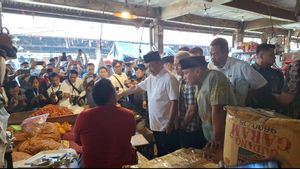JAKARTA - Tempe and tofu are rare. In fact, it is an authentic Indonesian food, which Americans sometimes give a cool name: soybean meat. In recent days, the names of tempe and tofu have made a comeback, after food ingredients that can be used as side dishes or snacks are hard to find in the market. Producers and sellers went on strike to protest the insane increase in the price of imported soybeans.
Soybean prices have almost doubled. In Jakarta, soybeans are usually sold for IDR 6000-9000 per kilogram. However, since last week the selling price of soybeans has been climbing, reaching Rp. 12 thousand per kilogram. Tempe and tofu producers are also gasping for air, because they have to spend almost twice as much as capital for soybeans.
"We, from tofu and tempeh craftsmen, apologize to the community of tofu tempeh lovers because this is forced, forced and forced by us. So we apologize," said Aip Syarifuddin, General Chairperson of the Indonesian Tofu and Tempe Producers Cooperative Association (Gakoptindo) when contacted by VOI, Friday, 18 February.
Tempe and tofu producers will go on a production strike for 3 days, February 21-23 2022. Since the end of December 2021 they have been restless because soybean prices continue to climb every day. Before deciding to strike, as the General Chair of Aip, he had implemented various proposals from members of Gakoptindo, such as: complaining to the government and replacing imported soybean raw materials with local soybeans. But the result is nil.

"At the end of December 2021, soybean prices began to rise, and they increase every day so that we are restless. So some regions, districts, groups, how about this, how about this. There are those who suggest that we tell the government, some say look for local soybeans, but nothing. Or we suggest the government to increase the price of tofu and tempeh, or ask for subsidies. At least the last strike," said Aip.
"That has been since December 2021. I conveyed the voices of the members to the government. However, it turns out that from the government, in December, January, until mid-February there was no concrete action in the field," said Aip again.
Gakoptindo believes that the government has paid little attention to tofu and tempeh craftsmen. This is indicated by the increase in soybean prices that continue to occur every year.
Indonesia is the Largest Soybean Consumer After ChinaIndonesia is a country with the second largest soybean consumption rate in the world after China. The level of Indonesian soybean consumption continues to increase along with the increase in population. According to data from the Central Statistics Agency (BPS), in 2015 the level of Indonesian soybean consumption was 3.010 million tons. Five years later in 2020, the national soybean consumption level touched 3.130 million tons.
But it is ironic, because Indonesia mostly fulfills soybean consumption needs through imports. Imports of Indonesian soybeans also continue to increase in line with the increasing demand for soybean consumption. Data from the economic journal published by the Padang State University in 2020, Indonesia's soybean imports in 2015 amounted to 2.637 million tons. In 2020 that number will swell to 3.398 million tons.

On the other hand, the area of agricultural land in Indonesia is also shrinking from year to year. In the 1980s until the early 1990s, the area of soybean farms in Indonesia had shown a significant increase. From 0.732 million hectares in 1980, the area of soybean farming became 1.667 million hectares in 1992. However, since then the area of soybean farming has continued to decline, until only 680 thousand hectares remained in 2018.
The area of land that continues to decline clearly has an impact on soybean production which is also degraded. According to data from the Ministry of Agriculture, national soybean production during the 2015-2019 period decreased by 15.54 percent per year. Obviously, it is impossible to expect the fulfillment of the national demand for soybeans from local production.
Soybean Farms in the United StatesSoybean import is a way that is taken by Indonesia to meet national needs. Currently there are five main countries as soybean importers for Indonesia. The five countries are: the United States (2.15 million tons), Canada (232 thousand tons), Argentina (89.9 thousand tons), Brazil (9.24 thousand tons), and Malaysia (5.5 thousand tons). These figures are data released by BPS in 2021.
In contrast to Indonesia, the United States as the main supplier of soybeans to the country actually experienced an increase in the area of soybean farming. In 2017, the area of soybean farming in Uncle Sam's country was 90.2 million hectares. A year later, that number increased by 800 thousand hectares to 91 million hectares.
The United States refers to special areas for soybean farming as soybean belts states. Its territories are spread throughout the country, namely: Nebraska, Illinois, Indiana, Iowa, Ohio, Carolina, Virginia, Kansas, Texas, New Mexico, Georgia, Minnesota, and New York. The United States government has found the right formulation, that new soybean planting is profitable if it is carried out on a large area of land.

Therefore, every soybean farmer in the United States, which is usually passed down from generation to generation, cultivates an average of 100 hectares of land specifically for this grain agricultural commodity. Even according to the Indonesian Agricultural Research and Development page, there are farmers in the United States who cultivate up to 800 hectares of land specifically for soybeans.
Soybean varieties in the United States are also divided according to groups, ranging from 0 to VII. Each of these soybean varieties is distributed to different states, depending on the characteristics of the soil and the weather conditions in which the farm is located.
Through advanced agricultural technology, the quality of United States soybeans is recognized to exceed the quality of local soybeans. Still according to Aip who illustrates the superior quality of imported soybeans compared to local varieties. According to the General Chairperson of Gakoptindo, 1 kg of imported soybeans can grow to 1.6-1.8 kg after being cooked. Meanwhile, local soybeans from 1 kg will only get 1.4-1.5 kg after being cooked.
"The quality of local soybeans is indeed lower than that of imported soybeans, so most tempeh craftsmen prefer imported soybeans," said Aip again.
Threat to Local FarmersIndonesia actually also has soybean farming centers, such as in the United States. East Java is the largest supplier, followed by Central Java, West Java, West Nusa Tenggara, Lampung, and Nanggroe Aceh Darussalam. However, the constraint of land shrinkage does not make the national soybean centers develop.
Indonesia's increasing dependence on imported soybeans clearly endangers the potential of local agriculture. Soybean farmers will find it harder to sell their agricultural products if the land is getting narrower, plus the varieties that are less superior.

National consumers who are more interested in buying imported soybeans are also an inhibiting factor for local farmers to plant soybeans. Indonesia's dependence on imported soybeans also makes soybean prices in the market volatile and difficult to control even by the Indonesian government.
The Indonesian government has issued a policy of Regulation of the Minister of Trade of the Republic of Indonesia No. 45/M-Dag/Per/8/2013 and the 2015-2019 Ministry of Agriculture Strategic Plan to protect local farmers. The contents of the policy are to stabilize soybean prices and make plans for soybean self-sufficiency in 2016.
However, this regulation does not work, because Indonesia does not have enough land to grow soybeans. It is useless to develop superior varieties if there is no land to plant them. So don't be surprised if the price of soybeans will continue to rise and fall, and tempeh and tofu are becoming a rare item.
The English, Chinese, Japanese, Arabic, and French versions are automatically generated by the AI. So there may still be inaccuracies in translating, please always see Indonesian as our main language. (system supported by DigitalSiber.id)












